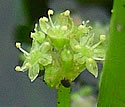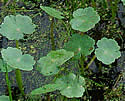Hydrocotyle ranunculoides (Floating Pennywort)
| Also known as: | Buttercup Pennywort, Floating Marsh-pennywort, Water Pennywort |
|---|---|
| Genus: | Hydrocotyle |
| Family: | Araliaceae (Ginseng) |
| Life cycle: | perennial |
| Origin: | native |
| Habitat: | part shade, sun; marshes, ponds, lake edges, slow moving water |
| Bloom season: | September |
| Plant height: | 4 to 12 inches |
| Wetland Indicator Status: | GP: OBL MW: OBL NCNE: OBL |
| MN county distribution (click map to enlarge): |  |
| National distribution (click map to enlarge): |  |
Pick an image for a larger view. See the glossary for icon descriptions.
Detailed Information
Flower: 

![[photo of flowers]](/udata/r9ndp23q/pd/hydrocotyle-ranunculoides-7934-8-t.jpg) Rounded clusters about ½ inch across of 5 to 10 star-shaped, nearly stalkless flowers at the end of a naked stalk, ½ to 2 inches long, arising from the leaf axils, which are typically just under the water surface. Flowers are 1/16 to 1/8 inch across with 5 small white to green petals and 5 spreading white stamens.
Rounded clusters about ½ inch across of 5 to 10 star-shaped, nearly stalkless flowers at the end of a naked stalk, ½ to 2 inches long, arising from the leaf axils, which are typically just under the water surface. Flowers are 1/16 to 1/8 inch across with 5 small white to green petals and 5 spreading white stamens.
Leaves and stems: 

![[photo of leaves]](/udata/r9ndp23q/pd/hydrocotyle-ranunculoides-13-2-t.jpg) Leaves are round to kidney-shaped, ¾ to 3 inches wide, with 3 to 7 rounded toothed, shallow lobes around the edge and a deep cut at the base, on a smooth stalk 2 to 12 inches long rising far above the flowers.
Leaves are round to kidney-shaped, ¾ to 3 inches wide, with 3 to 7 rounded toothed, shallow lobes around the edge and a deep cut at the base, on a smooth stalk 2 to 12 inches long rising far above the flowers.
![[leaf underside]](/udata/r9ndp23q/pd/hydrocotyle-ranunculoides-7934-12-t.jpg) The leaf stalk is attached on the underside of the leaf at the base of a deep sinus, appearing to be in the center of the blade. The blade is held horizontal, parallel to the ground. Stems are on or just below the water's surface, horizontal, heavily branched, rooting at the nodes and often creating dense colonies with a thick tangle of roots.
The leaf stalk is attached on the underside of the leaf at the base of a deep sinus, appearing to be in the center of the blade. The blade is held horizontal, parallel to the ground. Stems are on or just below the water's surface, horizontal, heavily branched, rooting at the nodes and often creating dense colonies with a thick tangle of roots.
Notes:
Floating Pennywort in Minnesota is a disjunct population of what is primarily a southern species. The Shakopee Mdewakanaton Sioux Community first documented the species on their lands in Scott County in 2007, where there is a stable population in three wetlands. It was possibly transported here by waterfowl. It is rumored to have been discovered in Dakota County as well but, as far as we know, has not been confirmed. Sold around the world as a water garden plant, it has become invasive in Australia and parts of Europe due to its propensity to form dense colonies. Also discovered in Wisconsin in 2010 at Delavan Lake, the WI DNR declared it a non-native invasive species, too, and is apparently working on eradication. A similar species is American Water Pennywort (Hydrocotyle americana), a Minnesota Special Concern species, which is decidedly branched with stalkless flower clusters in the leaf axils, and not typically found in open water. The leaves of Floating Pennywort somewhat resemble those of a few buttercup (Ranunculus) species but the aquatic forms all have very finely divided submersed leaves which Hydrocotyle lacks, as well as distinctly yellow flowers.
Native Plant Nurseries, Restoration and Landscaping Services ↓
More photos
 a colony (not especially dense) of Floating Pennywort
a colony (not especially dense) of Floating Pennywort more flowers
more flowers leaves among the cat-tails
leaves among the cat-tails Floating Pennywort habitat
Floating Pennywort habitat a sense of scale
a sense of scale
Photos courtesy Peter M. Dziuk taken at a pond outside Mystic Lake casino, Scott County.
Comments
Have you seen this plant in Minnesota, or have any other comments about it?
on: 2014-09-18 10:21:41
I have seen this species at Sunset Pond in Burnsville. I have some documentation photos that include the flowers.






